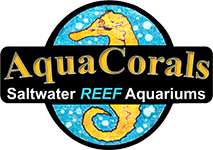There are many color variations in the Star Polyps soft coral family but this one is an ALL-TIME favorite & Best Seller here! Sporting a purple rubbery base it has metallic green polyps which have an intense fluorescent green which is evident under full daylights but screams under actinic blues! The polyps of this soft coral can grow longer than most giving is a grassy field look in the areas it's growing. A very hardy soft coral which can be placed in any well lit area of your tank.
All corals like plants want to grow towards the light source. Easily control where it grows by placing it against your tank wall to so it will creep onto the glass OR place small rocks at the leading growth edge so it grows onto these rocks which are easily harvested & the polyps have gone no further OR, just let it go & be a beautiful rock cover as I did below in the parent tank pic!
The first pic is a Parent and the smaller pic is a sample baby unless a WYSIWYG is offered & selected. Babies are mounted to real live rock.
# 4 in the pic below. EST. 1998

Soft Coral Color Guide: Example - Base color "Green"
"Green" = shows it's green color mostly under actinic blue lighting
Neon "Green" = shows it's green under full daylight but is more intense green under actinic blue lighting
Ultra "Green" = shows it's green under full daylight but literally "Glows" green under actinic blue lighting! These stand out over all!
Metallic = the color has a metallic sheen to it.
What a soft coral displays for color is greatly dependent on where it's positioned in relation to your light & the intensity & color of light above it. Most soft corals lighten in color as they expand (much like a balloon does when blown up) and often intensifies in color &/or looks darker when closed due to tissue concentration.
Like wild soft corals, aquacultured tank raised soft corals offer many benefits to reef fish like hiding places or perches and even sleep spots! Tank raised soft corals are much easier to keep than hard corals and they add beautiful form, color and movement to a tank.
My Parent Tanks as well as baby soft coral pics are taken under "full daylight" which is an equal mix of 10K & actinics. I work hard to represent my soft corals as they are without color doctoring photos. Use my images as a guide & expect some variances given your tank conditions vs mine.
To get the same results, give your corals approx. 6 hours a day of "full daylight". Resist the urge to keep them in blue actinic color POP phase. Sunrise then high noon full daylight then sunset over 10-12 hours is best.
